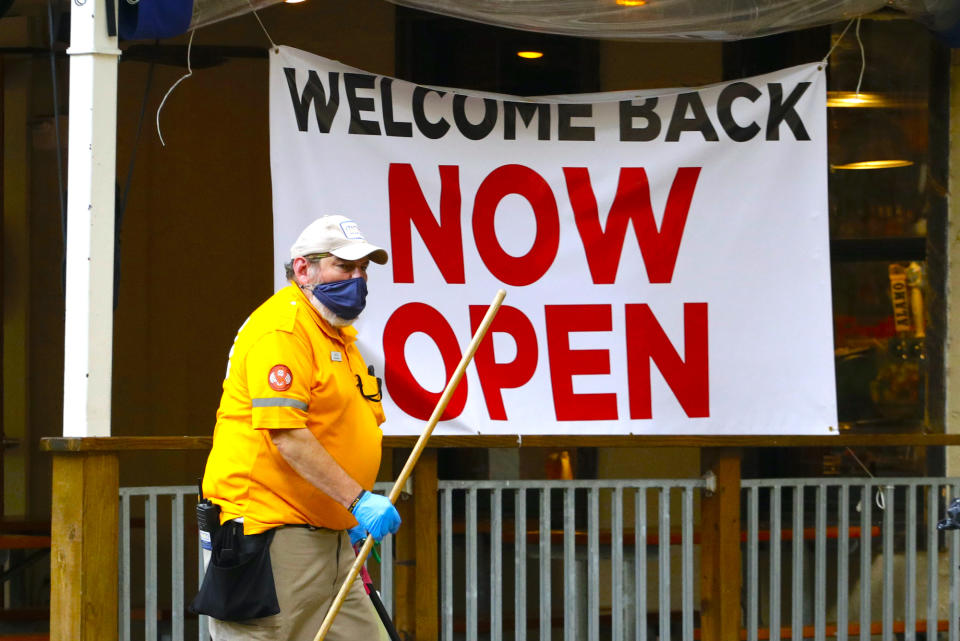Why a 10% plunge in spending is good news: Morning Brief
Thursday, May 14, 2020
Get the Morning Brief sent directly to your inbox every Monday to Friday by 6:30 a.m. ET. Subscribe
Slower declines are the new gains
When activity collapses in an economic crisis, before you can talk about a recovery you must first slow the rate of declines.
And so good news, relatively speaking, becomes characterized by a deceleration in the deterioration. You may recognize this from calculus class as a turn in the second derivative.
This is exactly what Bank of America’s credit and debit card activity has started to show.
“The daily data show meaningful improvement in spending into May, driven by the lower income population,” Bank of America economist Michelle Meyer wrote in a note to clients on Wednesday. “Total card spending is now running at a pace of -10% yoy over the 5-day period of May 3 - May 7, a big shift from the low of -36% yoy during the last 5 days of March.”
And when you’re looking into the economic abyss, a 10% drop in year-over-year spending turns into great news.
Late March was characterized by an economy that had been locked down in an effort to contain the spread of the coronavirus. Millions of Americans were filing for unemployment benefits during this period.
Meanwhile, we were only beginning to understand what kind of aid was coming in the form of fiscal stimulus. Amid all that uncertainty, it is understandable why spending collapsed.
So, what’s bolstering spending now? According to Meyer, it comes down to two big factors.
“There appear to be two critical reasons for the improvement in consumer spending: stimulus payments and phased reopening of the economy,“ Meyer said. “Focusing on retail sales ex-autos, spending is now actually increasing, running at a 1% yoy rate over the same 5-day period.”

The benefit of stimulus payments is simple. If your income goes to zero, then you can’t spend money. If the government hands you a check with no strings attached, you’ll probably start spending.
The boost from a phased reopening of the economy is an interesting one, because if consumers aren’t confident they won’t get sick, then they won’t go out. Unlike stimulus payments which are a known benefit to consumers, belief that the virus’ spread has indeed moderated could potentially upset these trends.
But early trends show that second derivative changes are likely to make activity look lively in states that loosen business restriction.
In Georgia, for instance, Meyer looked at a category where strangers come into close contact: beauty salons.
“Spending at beauty salons in GA averaged -46% yoy between May 1- 7th, up from the low of -96% in the beginning of April,” Meyer observed.
Yes, -46% is terrible. But it’s a whole lot less bad than -96%.
Of course, it’ll be a while before we know what kind of economic recovery we can look forward to as investors continue to debate which future path for growth is priced in.
But for now, you can take cold comfort in knowing that when it comes to consumer spending, it appears things have stopped getting worse.
By Sam Ro, managing editor. Follow him at @SamRo
What to watch today
Economy
8:30 a.m. ET: Import Price Index month-on-month, April (-3.1% expected, -2.3% in March)
8:30 a.m. ET: Initial Jobless Claims, week ending May 9 (2.5 million expected, 3.169 million prior)
8:30 a.m. ET: Continuing Claims, week ending May 2 (25.12 million expected, 22.65 million prior)
9:45 a.m. ET: Bloomberg Consumer Comfort, week ending May 10 (36.9 prior)
Earnings
Pre-market
7 a.m. ET: Norwegian Cruise Lines (NCLH) is expected to report a loss of an 47 cents per share on $1.28 billion in revenue
Post-market
4 p.m. ET: Applied Materials (AMAT) is expected to report earnings of 91 cents per share on $4.25 billion in revenue
Top News
Global stocks slide on rising US-China tensions and Fed warning
Intelsat files for Chapter 11 bankruptcy
Fed Chair Powell: Negative rates are 'not something that we are looking at' [Yahoo Finance]
SmileDirectClub reports bigger quarterly loss due to COVID-19 lockdowns [Reuters]
YAHOO FINANCE HIGHLIGHTS
You may soon receive additional COVID-19 stimulus checks from Uncle Sam: Goldman Sachs
Uber to require all drivers, passengers to wear masks worldwide
Retail stores reopening as coronavirus lockdowns lift
—
Follow Yahoo Finance on Twitter, Facebook, Instagram, Flipboard, SmartNews, LinkedIn, YouTube, and reddit.
Find live stock market quotes and the latest business and finance news
For tutorials and information on investing and trading stocks, check out Cashay

 Yahoo Finance
Yahoo Finance